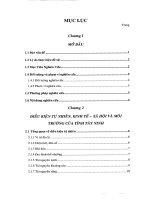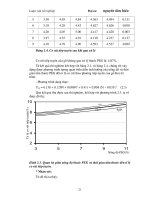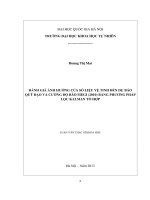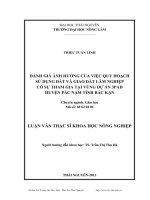ĐÁNH GIÁ ẢNH HƯỞNG CỦA TỔ HỢP PHÂN BÓN VI SINH VÀ PHÂN BÓN QUA LÁ ĐẾN SINH TRƯỞNG GIỐNG QUÝT NGỌT KHÔNG HẠT (Citrus unshiu Marc) TRONG GIAI ĐOẠN KIẾN THIẾT CƠ BẢN TẠI BẮC KẠN
Bạn đang xem bản rút gọn của tài liệu. Xem và tải ngay bản đầy đủ của tài liệu tại đây (227.7 KB, 6 trang )
<span class='text_page_counter'>(1)</span><div class='page_container' data-page=1>
<b>EFFECT OF MICRO ORGANIC FERTILIZER AND FOLIAGE </b>
<b>FERTILIZER ON GROWTH OF SWEET SEEDLESS MANDARIN IN </b>
<b>NON-FRUITING PERIOD AT BAC KAN PROVINCE </b>
<b>Nguyen Minh Tuan*, Ha Minh Tuan, Luan Thi Dep, Nguyen Ngoc Lan </b>
<i>TNU - University of Agriculture and Forestry </i>
ABSTRACT
The experiment was performed to measure the effect of micro organic fertilizer and foliage
fertilizer on vegetative growth of sweet seedless young mandarin cultivar at Bac Kan province in
2017. The experiment was designed in Randomized Complete Block Design (RCBD) with three
replications by four treatments. The characters of plant height, plant diameter, number of branch
level 1 and 2, shoot size and leaf number per shoot were recorded. The results showed that
application of 8 kg Song Gianh micro organic fertilizer/tree + Dau Trau 501 foliage fertilizer gave
the best performance in plant height (134.11 cm), plant diameter (93.44 cm), shoot length (18.75
cm; 26.75 cm; 22.08 cm in spring shoot, summer shoot and autumn shoot, respectively) as well as
leaf number per shoot with value of 11.17 leaf; 15.0 leaf and 14.58 leaf in spring, summer and
autumn shoot period.
<i><b>Keywords: Micro organic fertilizer; foliage fertilizer, sweet seedless young mandarin </b></i>
INTRODUCTION*
Fertilization is considered as an important
practice during the growing season to obtain
an economic yield and to improve the fruit
quality characters (Eman, 2006) [4]. Citrus
requires sixteen essential elements for normal
growth, production and quality. Adequate
supply of nitrogen, phosphorus and potassium
are important for citrus tree growth and
productivity (Quaggio et al., 2002 [8]).
Althought the chemical fertilizers are an
indispensable in fruit crop nutrition, using
enormous amounts of mineral fertilizers can
accumulate harmful nitrate in food causing
hazardous effects (El-Khawaga and Maklad,
2013 [3]). Bogatyre (2000) [1] also indicated
that mineral fertilizers and other chemicals
commonly used in agricultural production not
only have harmful effects on the environment,
but also they can modify the composition of
fruits, vegetables and root crops, and decrease
their contents of vitamins, minerals and other
useful compounds. They also adversely affect
to the soil fertility, water quality, yield and
quality of the products (Srivastava, 2012 [9]).
Bio-fertilizers are very safe for human,
*
<i>Tel: 0915 702128, Email: </i>
animal and environment. They are biological
preparations containing primarily potent
strains of microorganisms in sufficient
numbers. These microorganisms have definite
beneficial roles in the fertility of soil
rhizosphere and the growth of the plants.
Several researchers reviewed the significant
role of organic manures, micro organic
fertilizer and bio-fertilizers in influencing the
soil properties and enhancing the growth,
yield and quality of citrus (Khehra and Bal,
2014 [6]). Thus, using organic fertilizer,
micro organic fertilizer and bio-fertilizers in
farming is a good alternative choice to reduce
uses of chemical fertilizers (Krauss, 2000
[7]), and it has also assumed great importance
for sustainable production and to improve the
soil physical, chemical and biological
properties (Ennab, 2016 [5]).
</div>
<span class='text_page_counter'>(2)</span><div class='page_container' data-page=2>
growth performance of sweet seedless
<i>mandarin (Citrus unshiu Marc) under </i>
application of micro organic fertilizer and
foliage fertilizer lacking so far.Therefore, the
aim of this work is to evaluate vegetative
growth of mandarin sweet seedless in
response to fertilizer compound under field
conditions.
MATERIALS AND METHODS
<i><b>Plant materials </b></i>
The experiment was carried out in 1 year old
<i>sweet seedless mandarin (Citrus unshiu Marc) </i>
cultivar from January to December 2017 at
Bac Kan province. Trees were one year old
sweet seedless mandarin grafted on grapmelo
rootstock, planted at 4 m x 4 m distances.
<i><b>Experiment treatment </b></i>
The experiment of four treatments including
the control was designed in Randomized
Complete Block Design (RCBD) with three
replications. Each replication contained three
uniform plants. The experiment included four
treatments as follows:
Treatment 1: withour micro organic fertilizer
+ foliar Dau Trau fertilizer 501 (Control)
Treatment 2: 8 kg Song Gianh micro organic
fertilizer/tree + foliar Dau Trau 501
Treatment 3: 12 kg Song Gianh micro organic
fertilizer/tree + foliar Dau Trau 501
Treatment 4: 16 kg Song Gianh micro organic
fertilizer/tree + foliar Dau Trau 501
Mineral fertilization was applied with
ammonium sulphate at 0.5 kg/tree, super
phosphate at 0.5 kg/tree and potassium
sulphate at 0.3 kg/tree. Nitrogen and
potassium fertilizer was added on two periods
in Ferbruary and in the end of August.
Whereas, super phosphate was applied on
three periods, in Ferbruary, May and in the
end of August. The micro organic fertilizer
was applied on four periods in Ferbruary,
May, August and in the end of October. Foliar
Dau Trau 501 was applied on windless
mornings with a truck-mounted monitorized
sprayer until drip off and subsequently in 1
month intervals.
<b>Data Collection </b>
Number of shoot per tree was determined by
choosing randomly three trees, and the
number of shoot was counted. Later shoot
maturity (length and diameter) were also
measured with vernier calipers. Leaf number
per shoot was evaluated by choosing
randomly four shoots on each tagged tree, and
the number of leaf was counted
<b>Statistical analysis </b>
The data obtained from the study were
analyzed using SAS 6.12 statistical software.
The least significant difference was calculated
following a significance F-test (at p≤ 0.05)
RESULTS AND DISCUSSION
<i><b>Effect of micro organic fertilizer and foliage </b></i>
<i><b>fertilizer on vegetative growth of sweet </b></i>
<i><b>seedless madarin cultivar </b></i>
From the results of Table 1, it was found that
there were significant differences among
treatments concerning plan height. In control
treatment, plant height was recorded as the
lowest value at 121.33 cm, while the highest
plant height value was found in T2 and T3
treatment at 134.11 cm and 130.0 cm,
respectively. Moreover, the results summarize
in Table 1 showed that T2 treatment were
</div>
<span class='text_page_counter'>(3)</span><div class='page_container' data-page=3>
observed at the T2, T3 and T4 treatments,
whereas the untreated control produced the
lowest value of 4.11 branches level 1 per tree
(Table 1). Furthermore, the results in Table 1
showed that the control treatment had the
lowest amount of branch level 2 with a value
of 12.22 branches per tree while the highest
number of branch level 2 per tree was found
in T4 treatment with value of 14.56 branches
per tree. However, the difference was not
statistically significant (p<0.05).
<i><b>Effect of micro organic fertilizer and foliage </b></i>
<i><b>fertilizer on number of shoot in sweet </b></i>
<i><b>seedless madarin cultivar </b></i>
The results in Table 2 showed that there was
significant difference in spring shoot number
for all treatments in this study. In term, the T2
treatment has the highest spring shoots
number with value of 12.4 shoots per tree,
followed by T3 and T4 treatment with value
11.4 and 10.4 shoots per tree, respectively.
Whereas the lowest spring shoots number was
recorded at 8.2 numbers of shoots per tree in
control treatment. The same pattern was also
observed regarding to the number of summer
shoots. It showed that summer shoot number
was significantly increased in all treatment
except untreated control. In term, T2 treatment
had the maximum summer shoots number
(13.1 shoots per tree), followed by T3 and T4
treatment with value of 13.0 and 12.7 shoots
per tree, respectively. The minimum summer
shoots number 8.7 (shoots per tree) was
recorded in control treatment. For the autumn
shoot number, T2 treatment application
performed the maximum number of
shoots/tree (11.0), whereas the lowest value
was found in untreated control with 8.4
number of shoots/tree. However, the
difference was not statistically significant
(p<0.05).
<i><b>Table 1. Effect of micro organic fertilizer and foliage fertilizer on vegetative growth of sweet seedless </b></i>
<i>mandarin tree</i>
<b>Treatment </b> <b>Plant height </b>
<b>(cm) </b>
<b>Tree canopy </b>
<b>diameter (cm) </b>
<b>Number of branches </b>
<b>level 1 (branch/tree) </b>
<b>Number of branches </b>
<b>level 2 (branch/tree) </b>
<b>T1</b> 121.33
b<sub>* </sub> <sub>85.00</sub>a <sub>4.11</sub>a <sub>12.22</sub>a
<b>T2</b> 134.11
a
93.44a 4.89a 14.33a
<b>T3</b> 130.00a 92.44a 4.67a 14.11a
<b>T4</b> 127.22ab 86.89a 4.33a 14.56a
<b>P </b> <0.05 >0.05 >0.05 >0.05
<b>LSD.05 </b> 7.7 - - -
<i>*<sub>Means followed by different letter are significantly different within columns by Duncan’s multiple range </sub></i>
<i>Test, P ≤ 0.05 </i>
<i><b>Table 2. Effect of micro organic fertilizer and foliage fertilizer on number of shoot in sweet seedless </b></i>
<i>madarin cultivar</i>
<b>Treatment </b> <b>Spring shoot </b>
<b>number/tree </b>
<b>Summer shoot </b>
<b>number/tree </b>
<b>Autumn shoot </b>
<b>number/tree </b>
<b>T1</b> 8.2b* 8.7b 8.4a
<b>T2</b> 12.4
a <sub>13.1</sub>a <sub>11.0</sub>a
<b>T3</b> 11.4
a <sub>13.0</sub>a <sub>10.0</sub>a
<b>T4</b> 10.4
a
12.7a 9.6a
<b>P </b> <0.05 <0.05 >0.05
<b>LSD.05 </b> 2.1 2.3 -
<i>*<sub>Means followed by different letter are significantly different within columns by Duncan’s multiple range </sub></i>
<i>Test, P ≤ 0.05 </i>
</div>
<span class='text_page_counter'>(4)</span><div class='page_container' data-page=4>
<i><b>Table 3. Effect of micro organic fertilizer and foliage fertilizer on shoot character of sweet seedless </b></i>
<i>mandarin cultivar </i>
<b>Treatmen</b>
<b>t </b>
<b>Spring shoot </b> <b>Summer shoot </b> <b>Aurtum shoot </b>
<b>Shoot </b>
<b>length </b>
<b>(cm) </b>
<b>Shoot </b>
<b>diameter </b>
<b>(cm) </b>
<b>Leaf </b>
<b>number/ </b>
<b>shoot </b>
<b>(leaf) </b>
<b>Shoot </b>
<b>length </b>
<b>(cm) </b>
<b>Shoot </b>
<b>diameter </b>
<b>(cm) </b>
<b>Leaf </b>
<b>numbe</b>
<b>r/shoot </b>
<b>(leaf) </b>
<b>Shoot </b>
<b>length </b>
<b>(cm) </b>
<b>Shoot </b>
<b>diameter </b>
<b>(cm) </b>
<b>Leaf </b>
<b>numbe</b>
<b>r/shoot </b>
<b>(leaf) </b>
<b>T1</b> 10.83
c*
0.30 9.08c 20.92c 0.35 10.25d 20.58a 0.34 11.50b
<b>T2</b> 18.75a 0.38 11.17a 26.75a 0.39 15.00a 22.08a 0.39 14.58a
<b>T3</b> 18.42
ab <sub>0.32 </sub> <sub>10.75</sub>ab <sub>25.71</sub>ab <sub>0.38 </sub> <sub>13.00</sub>b <sub>21.58</sub>a <sub>0.38 </sub> <sub>14.50</sub>a
<b>T4</b> 16.67
b
0.36 10.33b 23.58bc 0.36 11.83c 21.08a 0.37 12.42b
<b>P </b> <0.05 <0.05 <0.05 <0.05 >0.05 <0.05
<b>LSD.05 </b> 1.8 0.6 3.1 0.7 - 0.9
<i>*<sub>Means followed by different letter are significantly different within columns by Duncan’s multiple range </sub></i>
<i>Test, P ≤ 0.05 </i>
<i>Shoot length </i>
The results of Table 3 showed that there was
significantly shoot length for all treatment in
in the case of spring shoot. In which, the
lowest shoot length (10.83 cm) was found in
the control treatment, while the highest shoot
length (18.75 cm) was observed in T2
treatment. Moreover, T3 and T4 treatments
also showed higher value of shoot length
compared to control treatment with value of
18.42 cm and 16.67 cm, respectively. The
similarity was also observed concerning the
shoot length in the case of summer shoot. The
results showed that the highest shoot length
with value (26.75 cm) was obtained with T2
treatment application, followed by T3 and T4
treatment application with value of 25.71 cm
and 23.58 cm, respectively, while the lowest
value of 20.92 cm was found in control
treatment. For autumn shoot, the results in
Table 3 indicated that the maximum shoot
length (22.08 cm) was recorded in T2
treatment application, whereas the control
treatment showed the minimum shoot length
(20.58 cm). However, there was no
statistically significant (p<0.05). These results
were similar to the finding of Dahiya et al.,
<b>(2013) [2]. </b>
<i>Shoot diameter </i>
For the shoot diameter, the results in table 3
showed that the highest shoot diameter of
0.38 cm was obtained in T2 treatment,
followed by T3 and T4 treatment, whereas the
control treatment showed the lowest shoot
diameter of 0.30 cm, which was found in the
case of spring shoot. However, summer shoot
showed that application of T2 treatment gave
the highest value (0.39 mm), whereas the
lowest (0.35 mm) was recorded in control
treatment. In the same table data, it showed
that T2 treatment application also produced
the highest value (0.39 cm), while minimum
of shoot diameter (0.34 cm) was obtained in
control, which was achieved in the case of
autumn shoot. This result was in agreement
with Dahiya et al., (2013) [2] who stated that
sweet orange trees fertilized with 70 kg
farmyard manure + 850 g urea/tree produce
more leaves, shoot length
<i>Leaf number per shoot </i>
From the results showed in Table 3, it was
observed that leaf number from untreated
control was lower than other treatments in the
case of spring shoot. In term, the control
treatment has the lowest leaf number with
9.08 leaves per tree, whereas the highest leaf
number recorded 11.17 leaves per tree in T2
</div>
<span class='text_page_counter'>(5)</span><div class='page_container' data-page=5>
leaves/shoot), whereas the lowest (10.25
leaves/shoot) was found in untreated control.
For the autumn shoot, the result showed that
the control treatment was found to have the
lowest value (11.5 leaves/shoot), whereas the
T2 treatment produced the highest leaf
number with value of 14.58 leaves/shoot,
followed by T3 and T4 treatment. These
results are in accordance with the findings of
Ennab, (2016) [5].
CONCLUSIONS
In conclusion, treatment with 8 kg Song
Gianh micro organic fertilizer/tree + foliar
Dau Trau 501 (T2 treatment) application was
the highest effective treatment in enhancing
vegetative growth parameters, shoot length,
diameter, as well as number of leaves per
shoot. Therefore, we recommended that
application of micro organic fertilizer and
foliage fertilizer as practical tools for
improving vegetative growth in sweet
seedless mandarin cultivar at Bac Kan
province with dose of 8 kg Song Gianh micro
organic fertilizer/tree + foliar Dau Trau 501 in
mandarin production.
REFERENCES
<b>1. Bogatyre A. N. (2000), “What are we to eat or </b>
how to live longer?”, <i>Pishchevaya </i>
<i>Promyshlennost, 7, pp. 34-35 (C.F. CAB). </i>
2. Dahiya S. S., Singh S., and Dalal R. P. (2013).
“Studies on the effect of organic manure versus
organic plus inorganic fertilizers in sweet orange
<i>(Citrus sinensis Osbeck) cv. Jaffa. Haryana”, J. </i>
<i>Hort. Sci, 42(1/2), pp. 9 - 12. </i>
3. El-Khawaga A. S., and Maklad M. F. (2013),
“Effect of combination between Bio and chemical
fertilization on vegetative growth, yield and quality
<i>of Valencia orange fruits”, Hortscience Journal of </i>
<i>Suez Canal University, 1, pp. 269 – 279. </i>
4. Eman El-Sayed K. A. E. (2006), “Effect of
biofertilization on reducing chemical fertilizers,
vegetative growth, nutritional status, yield and
<i>fruit quality of arabi pomegranate trees”, J. Agric. </i>
<i>& Env. Sci. Alex. Univ., Egypt., vol. 5 (3), pp. 1-23 </i>
5. Ennab H. A. (2016), “Effect of Organic
Manures, Biofertilizers and NPK on Vegetative
Growth,Yield, Fruit Quality and Soil Fertility of
Eureka Lemon Trees (Citrus limon
<i>(L.) Burm)”, J. Soil Sci. and Agric. Eng., </i>
<i>Mansoura Univ., 7(10), pp. 767- 774. </i>
6. Khehra S., and Bal J. S. (2014), “Influence of
organic and inorganic nutrient sources on growth
of lemon (Citrus limon (L.) Burm.) cv. Baramasi”,
<i>J. Exp. Bio. and Agri. Sci, 2(1S), pp. 126 – 129. </i>
7. Krauss A. (2000), “Quality production at
balanced fertilization: The key for competitive
<i>marketing of crops”, Proceedings of the 12th </i>
<i>CIEC International Symposium on Role of </i>
<i>Fertilizers in Sustainable Agriculture, August </i>
<i>21-22, 2000, Suceaua, Romania, pp. 1-16. </i>
8. Quaggio J. A., Mattos D., Cantarella H., Almeida
<i>E. L. E., and Cardoso S. A. B. (2002), “Lemon yield </i>
<i>and fruit quality affected by NPK fertilization”, </i>
<i>Scientia Horticulturae, 96, pp. 151 - 162. </i>
</div>
<span class='text_page_counter'>(6)</span><div class='page_container' data-page=6>
TÓM TẮT
<b>ĐÁNH GIÁ ẢNH HƯỞNG CỦA TỔ HỢP PHÂN BÓN VI SINH VÀ PHÂN BÓN </b>
<b>QUA LÁ ĐẾN SINH TRƯỞNG GIỐNG QUÝT NGỌT KHÔNG HẠT (Citrus </b>
<b>unshiu Marc) TRONG GIAI ĐOẠN KIẾN THIẾT CƠ BẢN TẠI BẮC KẠN </b>
<b>Nguyễn Minh Tuấn*<sub>, Hà Minh Tuân, Luân Thị Đẹp,Nguyễn Ngọc Lan </sub></b>
<i>Trường Đại học Nông Lâm - ĐH Thái Nguyên </i>
Thí nghiệm được tiến hành trên giống quýt ngọt không hạt (Citrus unshiu Marc) 1 năm tuổi tại tỉnh
Bắc Kạn năm 2017. Thí nghiệm gồm 4 cơng thức được bố trí theo khối ngẫu nhiên hoàn chỉnh
(RCBD) với 3 lần nhắc lại. Các chỉ tiêu về đặc điểm hình thái cây, số lượng lộc, đặc điểm lộc được
đo đếm theo dõi. Kết quả thí nghiệm cho thấy khi bón với lượng 8 kg phân hữu cơ vi sinh Sông
Gianh kết hợp với phân bón lá Đầu Trâu 501 cho giá trị cao nhất về chiều cao cây (134,11 cm),
đường kính tán (93,44 cm), số cành cấp I (4,89 cành/cây), cấp II (14,33 cành/cây) và cho giá trị
cao hơn về chiều dài lộc (18,75 cm; 26,75 cm; 22,08 cm trên đợt lộc xuân, lộc hè, lộc thu), số lá
trên lộc (11,17 lá/lộc xuân; 15,0 lá/lộc hè; 14,58 lá/lộc thu).
<i><b>Từ khóa: Phân bón hữu cơ vi sinh; phân bón lá; giống quýt ngọt không hạt </b></i>
<i><b>Ngày nhận bài: 17/9/2018; Ngày phản biện: 12/10/2018; Ngày duyệt đăng: 31/10/2018 </b></i>
*
</div>
<!--links-->








